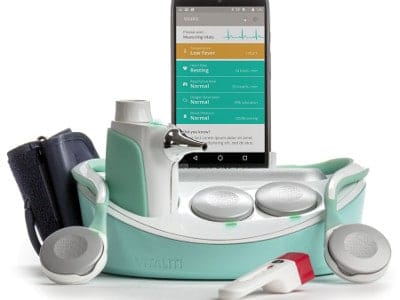
 Kitchener, Ontario’s Cloud DX is on one of seven finalist teams still in the hunt at the $10 million Qualcomm Tricorder XPRIZE competition, the objective of which is to discover a technology that resembles a Tricorder from the old Star Trek TV show.
Kitchener, Ontario’s Cloud DX is on one of seven finalist teams still in the hunt at the $10 million Qualcomm Tricorder XPRIZE competition, the objective of which is to discover a technology that resembles a Tricorder from the old Star Trek TV show.
Cloud DX has partnered with Stanford University researcher Dr. Shan Wang and his team at the Stanford Center for Magnetic Nanotechnology (SCMN), where he has has incorporated advanced Giant Magnetoresistance (GMR) biosensors developed at Stanford into the Cloud DX “Vitaliti” Tricorder.
The Tricorder is ripped directly from science fiction TV, used most famously as a portable diagnostic tool by cranky USS Enterprise physician Dr. Leonard “Bones” McCoy.
“We are thrilled to have an opportunity to work with Dr. Wang and his extremely talented doctoral & post-doc researchers to bring GMR technology closer to market,” said Cloud DX CEO Robert Kaul. “We believe that in the near future consumers will use safe, inexpensive systems and software like our Vitaliti Tricorder to take charge of their own health. The platform we are developing with Dr Wang will bring that vision closer to commercial reality.”
“The winning team will develop a Tricorder device that will accurately diagnose 13 health conditions (12 diseases and the absence of conditions) and capture five real-time health vital signs, independent of a health care worker or facility, and in a way that provides a compelling consumer experience,” says the Qualcomm Tricorder XPRIZE website.
Dr. Wang’s Stanford team, working under the name Eigen Lifescience, was the Distinguished Award winner of the 2014 Nokia Sensing XCHALLENGE for an earlier version of the same GMR technology that’s being used in the Team Cloud DX Tricorder.
“As a winner of the Nokia Sensing X-Challenge we have a good idea what it takes to win a competition like the Qualcomm Tricorder XPRIZE,” said Dr. Wang. “I am very pleased to be invited to join Team Cloud DX, who I believe has an excellent opportunity to be a grand-prize winner in 2017.”
SCMN’s Wang Group and Team Cloud DX will share any awards won by their joint efforts.
The 2007 Nobel Prize in Physics was awarded to Albert Fert and Peter Grünberg for the discovery of GMR, which is now in use in various magnetic field sensors.
GMR is different from standard enzyme-linked immunosorbent assay (ELISA) tests in that they are more sensitive, versatile and faster, measuring analyte levels in blood, saliva, urine or perspiration.
Finalist teams remaining in the Qualcomm Tricorder XPRIZE competition have until August 2016 to submit prototypes for consumer testing, with prizewinners expecting to be announced early in 2017.
Last November, Cloud DX’s FDA-cleared Pulsewave Health Monitor device was found to be comparably accurate to an intra-arterial blood pressure catheter by an independent clinical validation study carried out at the New Brunswick Heart Centre in Saint John.
Last September, Cloud DX won the Ontario Startup of the Year Award in the Innovation category, and took second place at the North America-wide Interface Health Challenge.
Leave a Reply
You must be logged in to post a comment.





 Share
Share Tweet
Tweet Share
Share




Comment